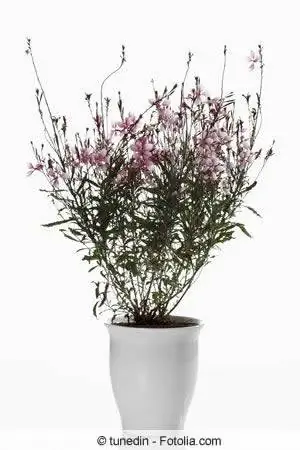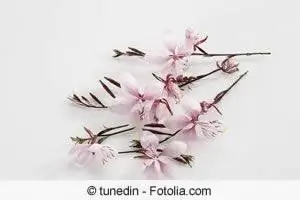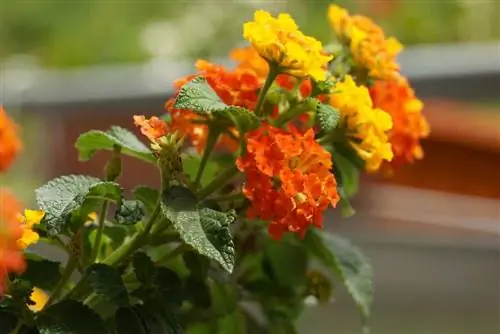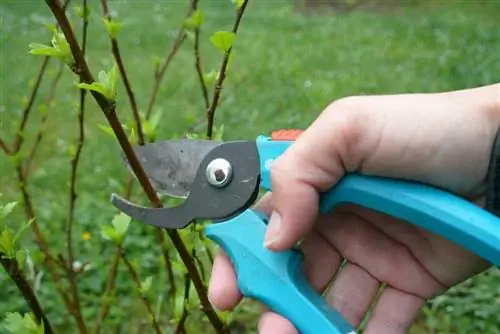- Author admin [email protected].
- Public 2023-12-17 03:39.
- Last modified 2025-01-24 12:45.
Gaura lindheimeri is a tireless, continuous bloomer that finds a place to thrive even on small terraces. From May to November, the magnificent candle delights the gardener with its short-lived, white to pink flowers. The plant, which belongs to the evening primrose family, comes from the south of the USA. Numerous cultivars have been enjoying growing popularity in our home gardens for years. The deciduous plant is more robust than expected. You can only give the prairie candle a little help during the cold season.
Location and soil
The plant with the butterfly-like flowers requires a full sun, sheltered location from the wind to produce this elegant, short-lived beauty. The magnificent candle can also cope with light partial shade, but this location can have a negative effect on flower formation. Some species of the bushy-growing plant can reach a height and width of over 1 meter. Other varieties, however, hardly grow higher than 50 centimeters and are therefore ideal as ground cover. Gaura lindheimeri does not place particularly high or exotic demands on the substrate. In ornamental beds it can cope with sandy soil just as easily as with a high lime content. Just avoid permanently moist soil or improve clayey soil with larger amounts of sand. In order to cover the prairie candle's low nutrient requirements, the substrate should only be deep and rich in humus. For potted plants, it is completely sufficient to use conventional potting soil.
Watering and fertilizing
Grand candles can cope better with short-term drought than with waterlogging. Watering is only carried out when the top layer of substrate feels noticeably dry. If necessary, do a touch test: check the moisture content of the soil with your index finger. If the top 2 to 3 centimeters feel crumbly and dry, add more water. This method prevents an oversupply of water. Because standing moisture can quickly lead to root rot. In the garden, you can prevent soil compaction by mixing small pebbles into the substrate when planting. If you are cultivating prairie candles in a container, drainage at the bottom is essential. This usually consists of non-rotting, porous material such as lava grit or clay scissors.
Tip:
Water only in the early morning or evening. This will prevent the valuable liquid from evaporating too quickly in the midday heat.
You can safely avoid regular fertilizer application when cultivating outdoors. In spring you can add nutrients to the soil by mulching the soil and mixing in compost. However, for plants in containers, you should add liquid fertilizer to the substrate approximately every 4 to 6 weeks during the main growing season. However, in the cold season you must stop adding fertilizer completely. Also look out for yellow-colored foliage. This is often a sign of an existing over- or under-supply of nutrients.
Planting
The delicate, deciduous perennial is often only cultivated as an annual plant due to its sensitivity to frost. However, in regions with mild winters, the plant itself ensures an annual “comeback” through strong self-seeding. It is not unusual that in this case you often have to limit the spread area of the prairie candle yourself. To avoid this, you should, for example, remove the wilted inflorescences before the seeds ripen. The magnificent candle is not only available as seeds, but also in pots in well-stocked garden centers. The best planting time for Gaura lindheimeri is early spring, when there is no longer any risk of night frosts that could damage the plant.
- The planting hole must have twice the circumference and depth of the root ball itself.
- Enrich the excavated soil with compost and pebbles.
- Remove the roots from the old substrate and insert them into the soil.
- Fill back the substrate and press it down lightly.
- Pour vigorously.

Bark mulch prevents the soil from drying out too quickly and provides additional protection from late frost. To do this, spread a 2 to 3 centimeter high layer around the plants.
Repotting
Splendid candles can also be kept in planters without any problems. Treat the plants to a new bucket in the second year at the latest. Alternatively, it is also sufficient if you completely replace the old substrate with new, humus-rich soil. In order not to damage the graceful flowers, which often extend from May to November, you should repot between the end of February and mid-March. Drainage at the bottom of the bucket is just as important as fresh nutrients. A thicker layer of soil serves as a buffer between the porous material and the delicate plant roots. There is no need to remove stunted or dead roots.
Propagate
If the location and care conditions match, you often don't have to worry about propagating the magnificent plant. In addition to growing seeds, you can also propagate the magnificent candle using cuttings. Slightly woody shoots about 10 centimeters long are used for this. You can use this method throughout the entire growing season.
- The cuttings are stripped of their leaves except for two upper pairs of leaves.
- Place 2/3 of the shoot in lean soil.
- Keep the substrate sufficiently warm and moist.
- Avoid direct sunlight.
You can tell whether and when root formation was successful by the emergence of new leaves and shoots. You can sow seeds in planters all year round. Here too, warmth and a moderately moist substrate promote rapid germination. Accustom the young plants to direct sunlight slowly to avoid irreparable leaf damage.
Cutting
Cut the plant back to about 10 centimeters above the ground before the new leaves form. This ensures increased, bushy shoots. You can also shorten old and withered inflorescences in the summer months to encourage Gaura lindheimeri to produce new flowers. Pruning in autumn or winter is not recommended. At this time the magnificent candle can no longer recover from the wounds. The cut edges therefore offer an ideal entry point for harmful viruses and fungal pathogens. The following also applies when cutting prairie candles: cleanliness and safety come first. Only use a well-sharpened knife or rose scissors, which you clean and disinfect adequately before and after work is done. This prevents potential pests and germs from being transferred to other plants via the tool.
Wintering
Prairie candles are more frost-resistant than is often assumed. Normally, the plants with their delicate flowers can easily survive sub-zero temperatures of up to 15°C. However, it is the humidity of local winters that often throws a spanner in the works. You can try to get the evening primrose family through the cold season unscathed using strong winter protection.
- Do not cut back the long shoots.
- Spread bark mulch or brushwood generously in the bed.
- Additionally cover the soil around the plant with burlap.
Despite all precautionary measures, rot often occurs on the roots. You can only avoid this in winter-hardy regions by cultivating Gaura lindheimeri in a planter all year round. The bucket is moved to a frost-proof, cool room at the end of September. Magnificent candles are among the “cold house plants”. It doesn't matter much whether the winter quarters are light or dark. In all cases, the summer green plant will shed its leaves. Only water the plant when the soil has noticeably dried out. Temperatures above 10° C or even direct proximity to radiators can lead to the death of the North American beauty.
- Relocate to a warmer, brighter environment from February.
- Prune in March.
- From May onwards, slowly get the plant used to the outdoors.
Conclusion
The flowers of the magnificent candle, which are reminiscent of butterflies, are a striking eye-catcher in your own garden. Even though you can only enjoy the short-lived flowers for a day or so, the full splendor lasts from May to November. Easy to care for and relatively undemanding, cultivating the prairie candle takes little time. The ornamental perennial can also be ideally cultivated with roses and low ground cover plants.






